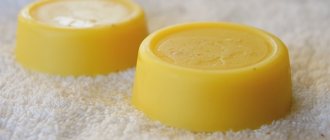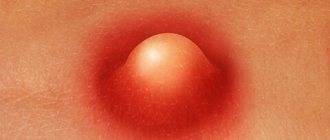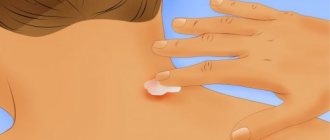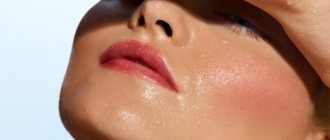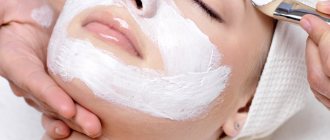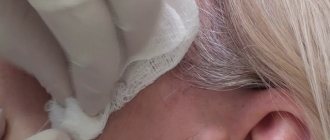Why does a scar form?
Keloids are divided into two groups according to their formation:
Primary (spontaneous)
These scars appear on apparently healthy skin for no apparent reason.
The appearance of such keloids can result from:
- Hormonal imbalances;
- Internal injuries;
- Pregnancy;
- Chronic diseases.
Typically, scarring occurs on the neck, back, chin and jaw line, ears, especially the earlobes.
Secondary (false)
Such scars occur in areas of previously damaged skin due to any injuries, skin lesions and ulcers. Wound healing is often inhibited by infection, causing inflammation and scarring.
The reasons include the following:
- Unprofessional surgical intervention;
- Injuries, cuts and wounds healed without proper care and supervision of a specialist;
- Consequences of severe skin diseases, such as acne.
What is a keloid scar and how to get rid of it: video
A keloid scar is an unpleasant cosmetic problem, the solution to which lies in comprehensive, competent treatment. The best result is achieved by a combination of active treatment methods (laser, cryotherapy, physiotherapy) and local exposure to medications (ointments, creams and injections).
A keloid scar is a structure that forms in places where the skin is injured and is a connective tissue. In this case, it is immature; under a microscope, such a scar looks like bundles of irregularly shaped collagen. The peculiarity of this structure is the ability to spread to healthy, undamaged skin.
How does a keloid scar form?
- at the site of skin damage, a thin layer of squamous epithelium is formed;
- within 10 days this “coating” becomes rougher, becomes denser and acquires a bluish tint;
- over the next 20 days, the keloid grows, swells, and begins to protrude 3-7 mm above the surface of the skin;
- Gradually, the growth of the scar intensifies, its surface becomes covered with plaques, and this process stops only after one and a half to two years.
In medicine, two types of keloid scars are classified:
- young formations - formation began no more than 5 years ago, the process of growth of connective tissue has not yet stopped;
- old – scars were formed more than 5 years ago, do not grow, and have a pale and “lumpy” surface.
Keloid disease is a condition in which such formations form in a person even after microscopic damage to the skin. In this case, they speak of a predisposition to the formation of keloid tissue. Often the disease is diagnosed in people of the black race, but some scientists argue that genetic predisposition is “triggered.”
With keloid disease, scars form in the most unexpected places - the inner thighs, the area around the lips, the inner side of the elbow.
The appearance of a keloid
There are three stages before the complete formation of a keloid:
- During the first 7-10 days, a thin epithelial layer appears on the affected area of the skin, which may be accompanied by painful sensations;
- Next, scarring occurs within 25-30 days, scar tissue protrudes above the main skin;
- After the formation of a scar in the affected area, the percentage of connective tissue increases, blood vessels disappear over time, and the scar becomes denser.
Stages of pathology development
In medicine, it is customary to distinguish several stages of colloid formation:
- The first stage of epithelization is when a primary film of epithelium is formed at the site of the wound, which becomes denser and coarser over the course of seven days. The scar lasts in this form for about two and a half weeks.
- The second stage of swelling is characterized by an increase in the size of the tumor, its elevation above the skin, and the presence of pain upon palpation. After four weeks, the pain goes away, but the redness increases.
- The third stage of compaction is caused by the formation of a colloid.
- The fourth stage of softening, in which the scar turns pale and pain disappears.
Symptoms
What should you pay attention to if you suspect a colloid scar?
- Smooth and constant growth;
- Change in skin color;
- Pain with pressure;
- Termination of excretory processes and hair renewal;
- Localization in areas characteristic of keloids.
Symptoms and signs
What signs are characteristic of this type of formation? Keloid scars are difficult to confuse with anything:
- the formation gradually grows, its size increases;
- the skin acquires a purple, bluish tint;
- when pressed, varying degrees of pain are felt;
- hair does not grow in this area, the body does not sweat;
- pulsation and itching are felt.
Note! Keloid tissue appears in the décolleté area, neck, chest, ears, and shoulder blades. Spontaneous appearance of other types of scars in these areas has not been recorded.
Medical intervention
If a colloid scar is detected at any stage, it is recommended to consult a specialist in dermatology or surgery. After examination and data collection, the doctor will make an accurate diagnosis and prescribe treatment.
The selection of drugs depends on the severity of the case, infectious infection and location on the body.
Treatment of colloidal scars is carried out using one of the following methods:
Gels, lotions and creams such as:
- Lyoton-1000;
- Laticort;
- Strataderm;
- Kelo-Kot;
- Kelofibraz.
Many drugs are sold at high prices and, despite active advertising, are characterized by low effectiveness. But you should not immediately abandon this method of treatment. Perhaps they will help you.
Therapy with drugs of these groups:
- Interferons. Beta/alpha interferons are injected into the affected area at a distance of a centimeter from each other. Procedures are carried out at intervals of one to two weeks;
- Corticosteroids. Medicines in this group affect the level of hormones in the blood and are injected into the keloid itself for at least a month;
- 5-fluoroacyl. Just like interferons, fluorouracil is injected directly into the scar tissue. The process is painful, but the procedure is effective. Injections are carried out every 3-4 days for about a month.
Application of physical influence:
- Laser resurfacing. As a result of laser removal, the keloid turns pale and decreases in size, but does not go away without a trace;
- Removal of colloid scar surgically. An equally effective method, but there is a risk of infection;
- Electrophoresis and phonophoresis with lidase, collagenase or corticosteroids. Used at the initial stage of keloid development;
- Irradiation with X-rays. Carry out after surgical removal of scars 4 times a day until the desired result is achieved;
- Cryosurgery. The affected tissues are frozen using liquid nitrogen; 3-4 procedures are enough for a visible effect.
Consequences
Many people are wondering whether colloidal scars are dangerous for the body? No, they are completely safe, and they get rid of this defect for purely aesthetic reasons. Discomfort may occur if the formation appears on joint bends and in places subject to constant friction.
In some situations, colloidal scars tighten tissue and skin, so they have to be hidden with clothing.
But malignant tumors can develop from these formations if radiation therapy is not promptly applied.
Home treatment
Time-tested folk remedies can be quite effective in preventing relapses and tumors.
Some folk remedies against keloids:
- Compresses and infusions of chamomile, geranium, St. John's wort, mint, yarrow, marshmallow root or larkspur, individually and in mixtures;
- Oils and extracts rich in vitamins, acids and antioxidants, for example, sea buckthorn, camphor, olive or melaleuca oil, known for its healing and healing properties;
- The well-known cabbage, in particular, crushed leaves of the plant with honey give a positive effect against colloidal scars.
Who is at risk?
Most often, true colloid scars occur in middle-aged people. False ones, in turn, can occur at any age as a result of past and chronic skin diseases, after severe burns, as well as in women during pregnancy due to very strong and uneven stretching of the rather delicate skin of the abdomen.
Medications
How to remove colloidal scar? Many lotions, creams, and ointments are expensive, and the effect of their use does not always justify the money spent. Modern medications are sometimes ineffective against some types of keloid scars.
You should not refuse to use local remedies. Perhaps in your case the formation will gradually resolve.
Use:
- Lyoton-1000;
- Hydrocortisone ointment;
- Contractubex;
- Zeraderm ultra;
- Kelofibrazu.
Prevention
By following simple rules, you will not only protect yourself from the growth of operated or treated scars, but also prevent the appearance of new keloids on the body.
To protect against colloidal scars you must:
- Do not allow tissue tension around the keloid;
- Do not take risks by trying to cure a scar on your own;
- It is forbidden to massage or put pressure on the damaged area;
- Do not expose the colloid to direct sunlight and avoid high temperatures;
- Let treatment take its course, ignoring and neglecting the advice of a specialist.
With proper care and timely treatment, this problem will not cause you much trouble and worry.
